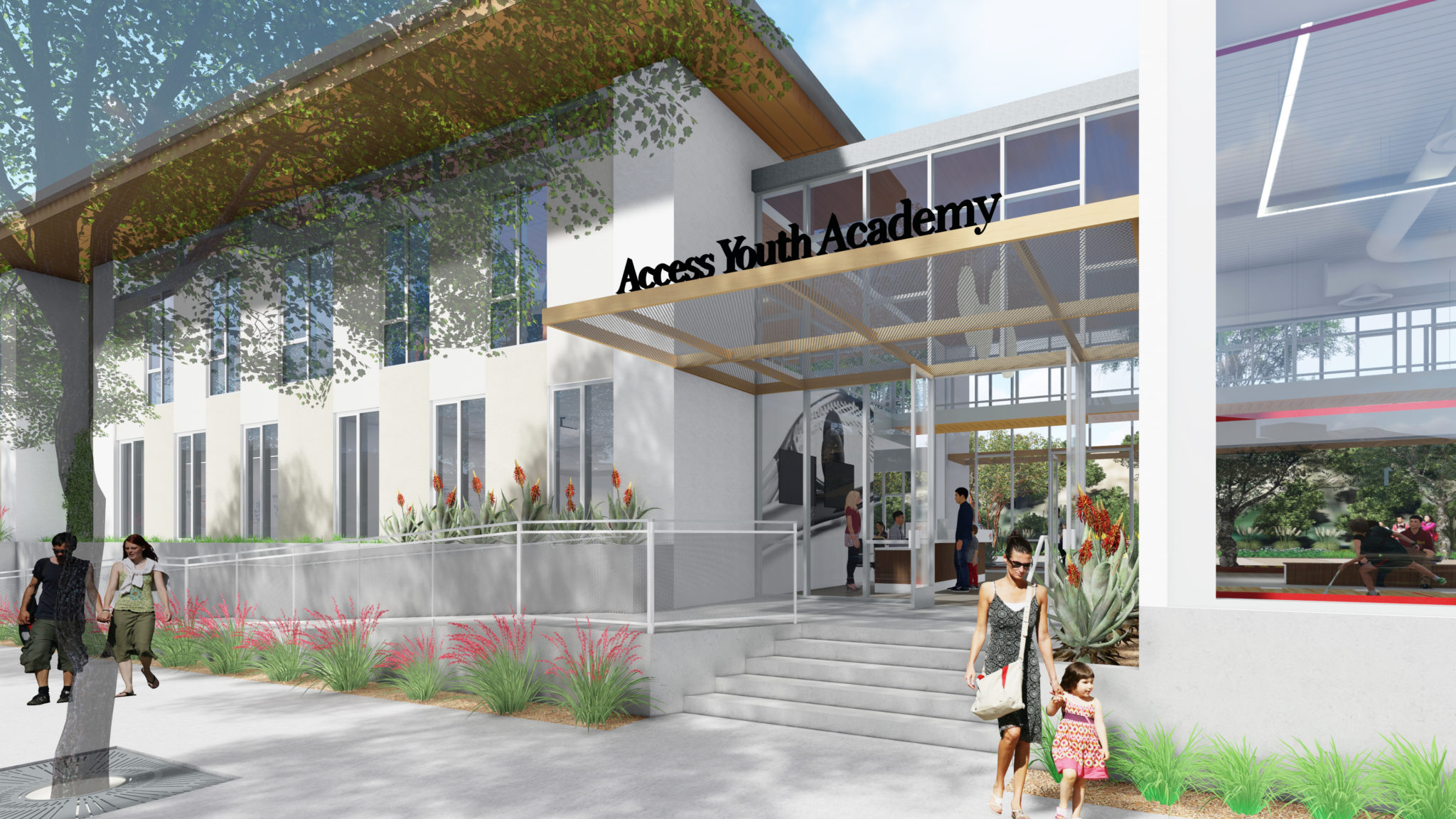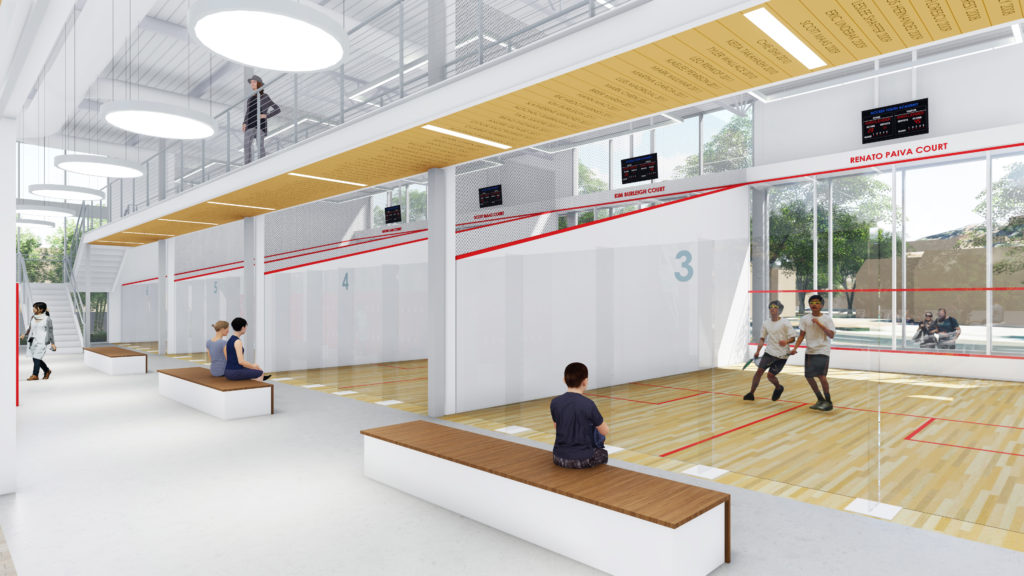
Collaborative approach unlocks $12M project transforming youth lives
Mission Driven Finance, Civic San Diego, and Alliance Healthcare Foundation provide critical funding for nonprofit Access Youth Academy’s new athletic and academic facility in Southeast San Diego
(SAN DIEGO)—January 15, 2019—Mission Driven Finance recently announced a coordinated investment with Civic San Diego and Alliance Healthcare Foundation to support the growth of Access Youth Academy. Access, a local nonprofit organization, engages with youth through scholarship and sportsmanship to transform their lives.
Transforming Youth Lives
Seeking to grow and serve more students, Access is transforming a vacant lot in Southeast San Diego into a vibrant, inspiring athletic and academic facility.
Access Youth Academy has a unique approach to youth development through the sport of squash. Access starts working with students in 7th grade and continues mentorship through college and two years beyond. This long-term investment of care transforms students’ lives and supports healthy choices. Not only does Access promote active lifestyles, confidence, and leadership, but it also opens doors to elite education institutions.
Many colleges, especially on the East Coast, have underused athletic scholarships for squash. By developing squash skills and academic achievement in first-generation college students, Access Youth Academy helps them qualify for scholarships at leading universities. Since 2002, Access students have earned $6,300,000 in scholarships. A full 100% of Access alumni have graduated from high school and gotten accepted to college.
“Alliance Healthcare Foundation recognized the transformative power of Access Youth Academy in 2013 when they became our Innovation Initiative (i2) award winner. We understand the link of poverty and social determinants of health and the long-term positive network effect for the participants—and their siblings, parents, family, friends, neighborhood—of achieving a debt-free Ivy League college education through squash scholarships and the generational impact on future health and well-being in low-income neighborhoods. This was a deep investment in young members of our community in recognition of the ripple effects the Access transformational program provides,” said Elizabeth Dreicer, Alliance Healthcare Foundation’s interim executive director. “We are pleased to now also assist Access in relocating to their new home through our Program Related Investment (Impact Investment) program in partnership with Mission Driven Finance and Civic.”

Collaborative finance
This collaborative $800,0000 pre-development bridge loan unlocks a $12M project to build the new facility—to be largely financed with New Markets Tax Credits. Without this bridge financing, Access would have been unable to complete the required pre-development work in order to secure construction financing.
“We find new markets tax credit investments exciting because they bring outside capital into our low-income communities. However, significant upfront costs in these complex transactions make it challenging for smaller organizations to tap into these transformative programs,” stated Mission Driven Finance CEO David Lynn. “Taking a flexible approach to finance allows us to close gaps like this for Access Youth Academy and get more kids going to great colleges.”
Louie Nguyen, chief investment officer of
With this new facility, Access can reach more kids easily. Located one block north of the Market Creek plaza and just downhill from Horton Elementary School, the new building will have more connectivity to the community and public transit. For Access Youth Academy, having a dedicated building allows them to serve more first-generation college students and to earn income from the space during off-hours.
Mission Driven Finance’s private debt fund Advance supports nonprofits, social enterprises, and small businesses with project financing to advance economic opportunity in San Diego. Projects funded through Advance are too big for microfinance, yet too small for conventional bank financing. With this transaction, Mission Driven Finance has committed $1.8M to community-driven organizations across San Diego County.
###
About Mission Driven Finance
Mission Driven Finance is an impact investment firm and Certified B Corporation empowering community through new models of investing in social change. Launched in 2016, all of our funds and structured products are designed to close financial gaps that in turn will close opportunity gaps. Learn more about our community-connected capital approach and discover how easy it is to invest in your community.
About Alliance Healthcare Foundation
We work to advance health and wellness for the most vulnerable in San Diego and Imperial counties. We accomplish this work through collaborative funding, convening, and advocacy. We currently operate a portfolio of five programs: i2 is our innovation initiative, also referred to as “venture philanthropy”—based on the thesis that innovation capital (often high risk, high reward) is needed to transform the current paradigm (high cost and poor outcomes) and improve quality, increase capacity and reduce costs; Mission Support—based on the belief that trusting those closest to our constituents and providing core operating support for great organizations will best advance our mission; Responsive Funding—based on the belief that it is important to be responsive to time-sensitive community needs and opportunities; InvestUp—based on the belief that it is important to actively and strategically be looking for ways to meaningfully advance our mission and it is worth spending some or all of our corpus—beyond the earnings off of our endowment—if we can substantively, sustainably and positively change the dynamics; and Program-Related Investments, also referred to as “impact investments,” based on the thesis that we can activate our investment portfolio to achieve more positive impact. For more information, visit alliancehf.org


